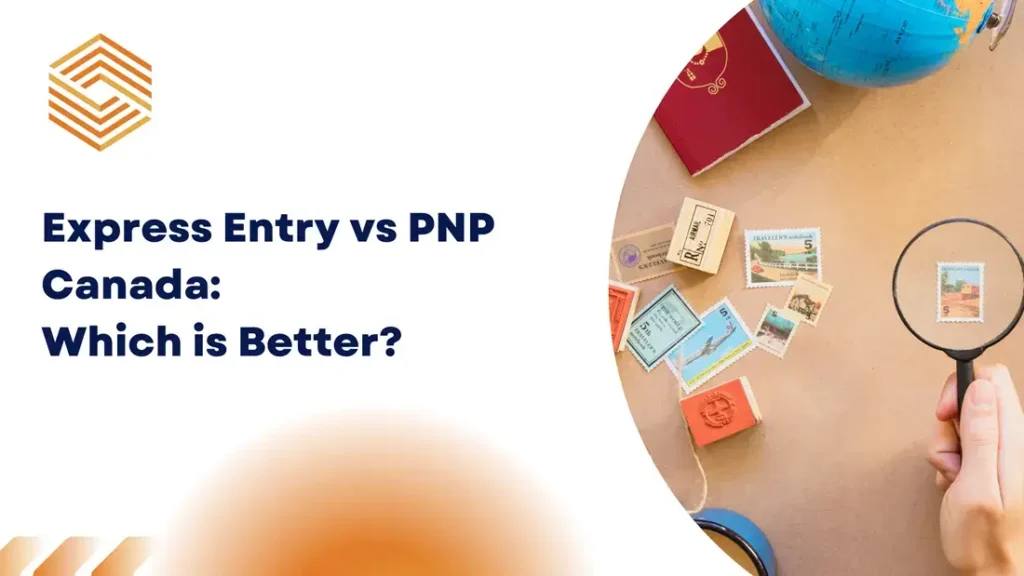
When it comes to immigrating to Canada, many skilled workers face the classic question: Express Entry vs PNP Canada – which one should you choose? In this detailed guide, we’ll explore this important topic using real insights, expert tips, and easy-to-understand explanations. Whether you are new to the process or exploring new options, you’ll discover what makes each program unique, how they work, and which pathway might suit your dreams of living in Canada.
Let’s dive into the details and answer the big question: Express Entry vs PNP Canada – which is better?
Express Entry vs PNP Canada: Which is Better?
Choosing between Express Entry vs PNP Canada is not just about speed – it’s also about finding the program that matches your skills, goals, and life situation. To help, we’ll explain each program in detail and show why many newcomers compare them.
What is Express Entry Canada?
Express Entry is an online immigration system launched by the Canadian federal government in 2015. It manages applications for permanent residency (PR) for skilled workers under three main programs:
- Federal Skilled Worker Program (FSWP)
- Federal Skilled Trades Program (FSTP)
- Canadian Experience Class (CEC)
Here’s how it works:
- You create an online profile and share your details, including age, education, work experience, and English or French language test results.
- You receive a Comprehensive Ranking System (CRS) score.
- Candidates with the highest CRS scores get an Invitation to Apply (ITA) for PR during regular draws.
What makes Express Entry popular is its transparency and relatively faster processing time (often as quick as six months after the ITA). It rewards candidates who have strong language skills, higher education, and Canadian work experience.
Expert Tip:
Before you start, always check your eligibility using the official IRCC eligibility tool. It can save you time and help you understand if you qualify.
Express Entry is highly competitive, and many applicants improve their scores by:
- Retaking language tests for better scores
- Gaining extra work experience
- Getting a valid job offer from a Canadian employer
- Completing a Canadian degree or diploma
What is PNP Canada?
The Provincial Nominee Program (PNP) is another important pathway for Canadian PR. Each province and territory (except Quebec) has its own PNP. These programs are designed to meet local labor market needs by attracting skilled workers, businesspeople, and even international graduates.
If a province nominates you, it usually means you’ll receive an extra 600 CRS points if you are already in the Express Entry pool, which almost guarantees an ITA. Alternatively, you might apply directly to the province through a “base” PNP stream not linked to Express Entry.
Each PNP has different requirements, but they all look for candidates who can:
- Fill jobs in demand in that province
- Have ties to the province, like previous study or work experience
- Plan to live and contribute to the province’s economy
Example Provinces Offering PNPs:
- Newfoundland and Labrador
- Prince Edward Island
- Nova Scotia
- New Brunswick
- Quebec (has its own system)
- Ontario
- Manitoba
- Saskatchewan
- Alberta
- British Columbia
- Yukon, Nunavut, and the Northwest Territories
Key Differences Between Express Entry and PNP
Many people compare Express Entry vs PNP Canada because both lead to PR, but they have some big differences:
| Feature | Express Entry | Provincial Nominee Program (PNP) |
| Managed by | Federal government | Provinces & territories |
| Points system | CRS score decides ITA | Province decides based on its own criteria |
| Processing time | Faster (about 6 months) | Longer (could be over 12 months) |
| Job offer | Helpful but not required | Often required or strongly preferred |
| Flexibility | Can live anywhere in Canada | Must live in nominating province |
Expert Insight:
If you don’t have a high CRS score, getting a provincial nomination can help you succeed. But remember, PNP is for those who genuinely plan to live and work in the nominating province.
How Does the Express Entry System and PNP Work?
Express Entry System:
- Create an online profile.
- Get a CRS score.
- Wait for regular draws.
- Receive an ITA if your score is high enough.
- Submit your PR application.
The Canadian government updates CRS cut-off scores regularly. It’s important to track these changes and plan accordingly.
PNP System:
- Apply directly to a province’s program or show interest while creating an Express Entry profile.
- Each province decides if you meet its local needs.
- Receive a nomination certificate.
- Apply for PR (either through Express Entry or directly).
The PNP is helpful for candidates with lower CRS scores or with skills in demand in specific provinces.
Why Are Express Entry and PNPs Often Confused or Compared?
Both programs aim to attract skilled workers and help them become Canadian permanent residents. They overlap because:
- Many PNPs work with Express Entry.
- Candidates often use PNPs to boost their CRS score.
- Both programs require similar documents (language tests, education assessments, work history).
Ultimately, both pathways are part of Canada’s strategy to meet economic and demographic needs.
Also Read: How to Apply for Canada PR from UAE
Pros and Cons of Express Entry vs PNP Canada
Let’s explore the strengths and weaknesses of each program.
Express Entry Advantages:
- Faster processing
- Flexibility to live anywhere in Canada
- No job offer required
- Simple online system
- Transparent CRS score
Express Entry Disadvantages:
- Highly competitive
- Harder for those with lower CRS scores
- Age can significantly reduce CRS points
Provincial Nominee Program (PNP) Advantages:
- Extra 600 CRS points if linked with Express Entry
- Opportunity for those with skills in demand in certain provinces
- Some PNPs require lower language scores
PNP Disadvantages:
- Slower processing in some provinces
- Must commit to living in the nominating province
- Requirements vary widely between provinces
Expert Tip:
For faster processing and fewer errors, prepare all documents early, stay updated with provincial draw announcements, and consider professional help for complex cases.
FAQs about Express Entry vs PNP Canada
Can I apply for Express Entry and PNP at the same time?
Yes! You can create an Express Entry profile and also apply to PNPs. Getting a nomination will boost your CRS score.
Can we apply for Express Entry after PNP?
Yes. If you receive a PNP nomination, you can use it to get extra CRS points and enter Express Entry.
How to get provincial nomination for Express Entry?
Research provinces where your job is in demand, meet eligibility criteria, and submit an Expression of Interest.
How long does it take to get PR after PNP?
Usually 12–19 months, but timing depends on the province and your application.
People Also Ask
Is PNP slower than Express Entry?
Yes, often it takes longer because provinces review nominations first.
Can I get PNP without Express Entry?
Yes, through “base” PNPs not linked to Express Entry.
Which province in Canada gives PNP easily?
Ontario, Saskatchewan, and Alberta have large quotas and regular draws.
Can I apply both Express Entry and PNP?
Yes, this strategy often helps applicants succeed.
Final Thoughts: Express Entry vs PNP Canada
Both Express Entry vs PNP Canada have unique benefits. Express Entry is ideal for candidates with strong CRS profiles and who want to live anywhere in Canada. PNP is better for those with connections to a province or skills in local demand.
For the best chance:
- Understand your strengths.
- Follow official updates.
- Prepare early.
- Seek expert advice if needed.
Either option can help you achieve your goal of living in Canada. Make your move to Canada stress-free. Connect with top-rated immigration consultants in Dubai today!
